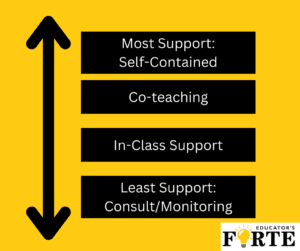Are you thinking about implementing co-teaching in your school? Many states have initiatives around co-teaching but don’t always provide the guidance needed for schools to get started.
There are a lot of things to consider when implementing co-teaching, but a good place to start is getting clarity of what co-teaching really means:
According to the Council for Exceptional Children:
“Co-teaching is a collaborative approach to instruction which two teachers, typically a general education teacher and a special education teacher, work together to plan and then implement instruction for a class that includes students with disabilities.”
In a true co-taught classroom, both certified teachers work together to do everything that happens in the classroom including planning, instruction, classroom management, and administrative tasks. Co-teaching does not mean that one teacher is there just to support the “main” teacher. It requires close collaboration between two certified teachers that yields dynamic instructional approaches that cannot be accomplished by a single teacher. Those approaches will better serve every student in the classroom.
Having a clear understanding of what co-teaching should look like is a good starting point. The next hurdle, and often the most challenging, is to figure out staffing configurations that will afford two highly qualified teachers in one classroom. In the first article in this series, we’ll help you walk through some key considerations in addressing staffing and student services as you begin planning for co-teaching in your school.

How Many Co-taught Classrooms Are Needed?
Co-teaching is one of many service-delivery models for students with disabilities, but it is not the only model. With that in mind, a good starting place in planning staffing is to consider which students in your school would most benefit from being in a co-taught inclusive classroom, and which students would likely be well-served in other service-delivery models.
Consider the students in your building with varying needs for support. Categorizing students with different learning disabilities based on the level of need for support —from least amount of support to the greatest amount of support—is a helpful exercise and good first step toward planning.
Spectrum of service options:

Making these decisions is a group effort. Gather input from all with vested interest including school leaders, special education teachers, general education teachers, and other professionals that support the students, such as guidance counselors, school psychologists, speech and language pathologists. Including members of the district-level special education team can also be extremely useful as they bring a wide range of expertise to the conversation.
As the group considers varying needs of students, it is key to remember that the goal is always the least restrictive environment. Find the place that fits student needs the best!
- High academic need, high behavior need-> top of spectrum
- High academic need, low behavior need-> middle of the spectrum
- Low academic need, high behavior need-> middle of the spectrum
- Low academic need, low behavior need-> bottom of the spectrum
Once you’ve sorted students into appropriate categories of support based on needs, you can begin to determine the number of co-taught classrooms you need (and at what grades/subjects), how many paraprofessionals are in needed for in-class support, how many self-contained classrooms are needed, how many resource teachers are needed, etc. This gives you the numbers that are needed for planning.
Which Teachers Should Co-teach?
The next step is putting the right educators in the right environment, and especially important consideration when choosing co-teaching partners.
- If it is an option, it is best to ask for volunteers to co-teach if that is an option. Teachers who are eager to co-teach can become champions for co-teaching as you grow it.
- Partner teachers with intentionality. If there is a special education and general education teacher that get along well then place them together. If a special education teacher is more comfortable with reading instruction, place them in a co-taught reading or English class if possible.
- If you need more teachers for co-teaching than you have volunteers, consider finding experienced co-teachers from your district (or other districts) who might come to a faculty meeting and share some of the many benefits of the model. This can often help teachers who are on the fence about co-teaching.
- If you have teachers who do not want to co-teach based on a past unsuccessful experience, keep in mind that that unsuccessful experience frequently arises form co-teaching situations that are not well-planned or well-supported. Helping teachers understand that your school is preparing for success can sometimes encourage additional volunteers.

Research tells us that what really makes or breaks co-teaching is the relationship between the co-teachers. Finding the right pairs and fostering that relationship will be vital to the success of co-teaching in your school.
The purpose of this article was to help you focus on key topics that you need to consider when planning for co-teaching in your school. In our next article, we’ll dig more into understanding co-teaching and what it should look like in the classroom.
Do you need help supporting co-teachers in your school? We may be able to help! Click here to take a look at Teaching in Tandem: Unlocking the Power of Co-Teaching.

